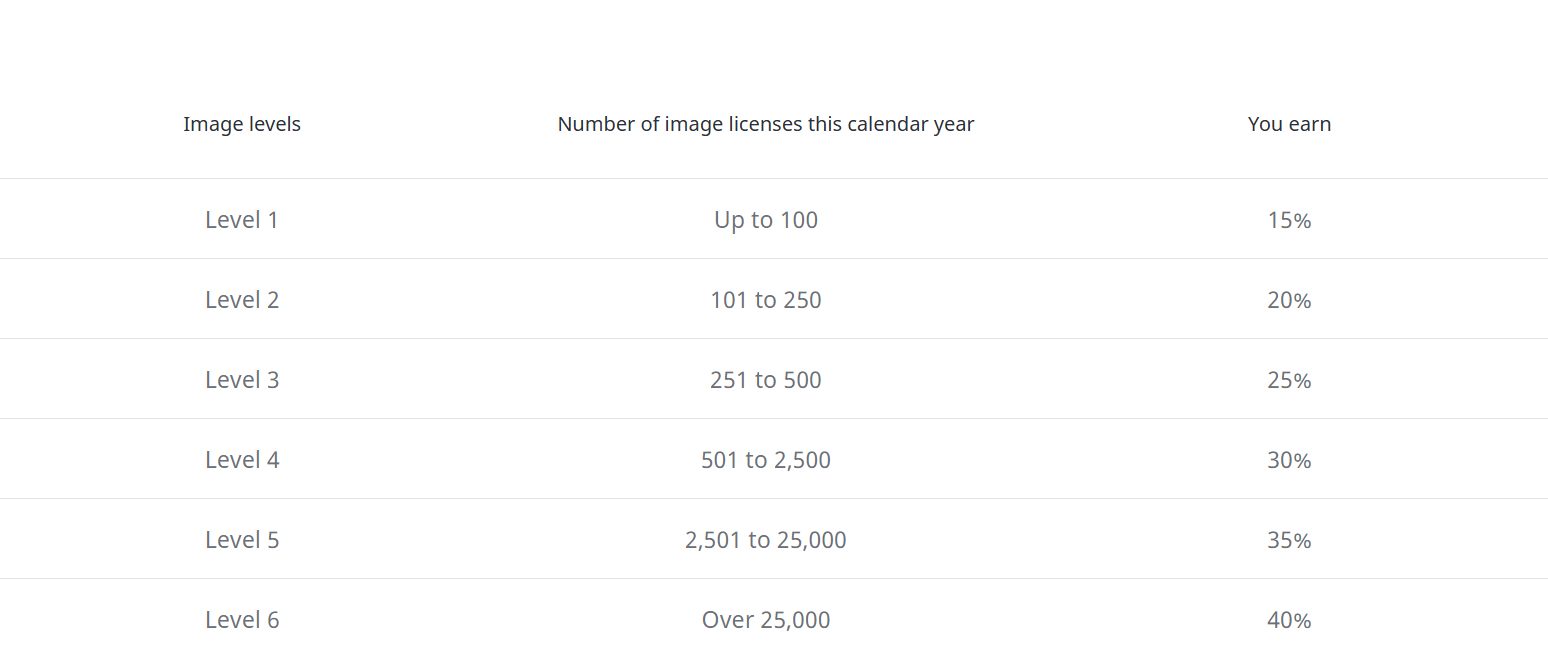If you’re passionate about photography, graphic design, or digital art, contributing to Shutterstock can be a fantastic way to earn some extra income. But before diving in, it’s important to understand how Shutterstock pays its contributors and what factors influence those payments. Payout rates can vary, and knowing the ins and outs helps you strategize your contributions effectively. In this post, we’ll unpack how
Factors Affecting Shutterstock Earnings for Contributors

Your earnings on Shutterstock aren’t set in stone—they depend on several important factors that can influence how much you make per download. Understanding these can help you optimize your contributions and increase your payout over time. Let’s break down the main elements:
- Contributor Level: Shutterstock uses a tiered system based on your sales volume. As you sell more images, you move up levels (from Standard to Expert), which typically results in higher payout rates per download. This means that consistency and volume matter if you want to earn more per sale.
- License Type: Shutterstock offers two primary types of licenses—Standard and Enhanced. Standard licenses are more common and generate lower royalties, while Enhanced licenses are less frequent but come with higher payout rates. Your download type directly influences your earnings.
- Customer Location: Where the customer is located can impact payouts. Shutterstock sometimes adjusts rates based on regional licensing laws and market demand. For example, downloads from certain countries might yield slightly different payouts.
- Subscription vs. On-Demand Purchases: Shutterstock offers both subscription plans and single-image purchases. Generally, subscription downloads tend to generate lower royalties per image, but because of volume, they can still contribute significantly to your overall earnings. On-demand sales often pay more per download but are less frequent.
- Image Quality and Relevance: High-quality, relevant images that match current trends tend to sell better. Shutterstock’s algorithms favor popular content, which can lead to more downloads and, consequently, higher earnings.
- Promotion and Portfolio Size: The more images you upload, the better your chances of making sales. Also, actively promoting your portfolio on social media or through other channels can increase visibility, leading to more downloads and higher payouts.
In summary, your Shutterstock earnings depend on a mix of your contribution level, content quality, licensing types, customer location, and sales strategies. Keeping these factors in mind can help you plan your approach and grow your income over time as a contributor.
How Shutterstock’s Payment Structure Works
So, you’re curious about how Shutterstock actually pays its contributors? Great question! Understanding the payment structure is key to managing your expectations and planning your contributions effectively.
At its core, Shutterstock operates on a royalty-based model. This means that every time someone downloads one of your images, you earn a percentage of the sale price. But it’s not just a flat rate—your earnings depend on several factors, including your contributor level, the type of license purchased, and whether the download is for standard or enhanced licensing.
Here’s a quick rundown of the main elements:
- Contributor Levels: Shutterstock has a tiered system—Standard, Advanced, and Exclusive. The higher your level, the better your payout rates. For example, exclusive contributors generally earn more per download than non-exclusive ones.
- License Types: Shutterstock offers Standard and Enhanced licenses. Standard licenses are more common and less expensive, while Enhanced licenses are used for higher-end commercial needs and pay higher royalties.
- Payment Thresholds: You need to reach a minimum payout amount (usually $35) before you can withdraw your earnings. Once you hit that threshold, you can request a payout via PayPal, Skrill, or bank transfer.
In addition, Shutterstock sometimes offers bonuses or promotional incentives, especially for top-performing contributors. They also have a clear payment schedule—earnings are calculated monthly, and payouts are processed usually within a week after the month ends.
It’s worth noting that Shutterstock also provides detailed dashboards where you can track your earnings in real-time, see which images are performing best, and adjust your portfolio accordingly. This transparency helps you understand how your contributions are translating into income.
To sum up: Your earnings depend on your contributor level, the license type, and the number of downloads. The more high-quality, licensed images you upload, the better your chances of increasing your income over time. Keep an eye on your dashboard, stay consistent, and you’ll see your payout grow!
Average Payout Rates per Download on Shutterstock
Now, let’s talk numbers. What can you really expect to earn per download? The truth is, it varies quite a bit, but having a ballpark figure helps you plan your creative efforts.
On Shutterstock, payout rates are typically expressed as a percentage of the license price. For standard licenses, the average payout is generally around 30% to 40%. For enhanced licenses, which are used for higher-quality or more commercial applications, you can earn approximately 50% or more.
Here’s a quick breakdown:
| License Type | Average Payout Rate | Typical Download Price Range |
|---|---|---|
| Standard License | 30% – 40% | $0.25 – $20 |
| Enhanced License | 50% or higher | $50 – $200+ |
Let’s put this into perspective with some examples:
- If a standard license is sold for $10, you might earn around $3 to $4.
- An enhanced license sold for $150 could net you roughly $75 or more.
Remember, these are averages—your actual earnings per download can be slightly higher or lower depending on your contributor level and whether you’re exclusive or non-exclusive. Additionally, Shutterstock sometimes updates its payout policies, so it’s always good to check the latest info in your contributor dashboard or their official FAQ.
Ultimately, earning on Shutterstock can be quite rewarding, especially as your portfolio grows and your images become popular among buyers. Patience and consistency are key, and over time, those small payouts add up to a nice income stream!
Tips to Maximize Your Earnings as a Shutterstock Contributor
Getting paid well as a Shutterstock contributor is all about working smarter and understanding what buyers are looking for. Here are some practical tips to help you boost your earnings and stand out in the crowded marketplace.
Stay Consistent with Uploads
One of the best ways to increase your earnings is by maintaining a steady flow of new content. The more high-quality images, videos, or vectors you upload, the higher your chances of making sales. Set a manageable upload schedule—whether it’s daily, weekly, or bi-weekly—and stick to it. Consistency keeps your portfolio active, which can improve your visibility in search results.
Focus on Trends and Niche Markets
Pay attention to current trends and popular themes in stock content. For example, topics like remote work, sustainability, or mental health are often in demand. Additionally, finding a niche—say, medical illustrations or drone photography—can help you become a go-to contributor in that area. Specialized content tends to attract more targeted buyers willing to pay a premium for unique, relevant visuals.
Optimize Your Keywords and Titles
Good metadata is crucial. Use descriptive, relevant titles and tags that accurately reflect your content. Think about what buyers might search for and include those keywords naturally. Avoid keyword stuffing, but ensure your keywords are specific and targeted. Proper optimization makes your content easier to find, increasing the likelihood of sales and, consequently, your payouts.
Create High-Quality Content
Quality always trumps quantity. Invest in good equipment, learn editing techniques, and pay attention to composition and lighting. High-resolution, professional-looking images and videos are more likely to be purchased or downloaded. Remember, Shutterstock has standards for quality, so submitting polished content will help you avoid rejections and build a strong portfolio.
Leverage Your Existing Content
If you have a backlog of approved content, revisit your top performers. Promote your work on social media or personal websites to attract more views and downloads. Sometimes, a little extra effort in marketing can lead to a spike in sales, boosting your earnings without additional uploads.
Participate in Shutterstock Challenges and Promotions
Shutterstock occasionally runs contests or promotional events. Participating can give your work extra exposure and sometimes even qualify you for bonuses. Keep an eye on the contributor dashboard and community forums for opportunities to get involved.
Conclusion and Final Thoughts on Shutterstock Payouts
Understanding Shutterstock’s payout rates is key to making the most of your contributor journey. While the base rates might seem modest at first, the real earning potential comes from consistent uploads, niche specialization, and optimizing your content for search. Remember, building a successful portfolio takes time, patience, and dedication, but with the right approach, you can turn your creative passion into a steady income stream.
Keep learning, stay updated on market trends, and don’t be afraid to experiment with different types of content. Over time, your efforts will pay off, and you’ll find yourself earning more per download as your reputation and portfolio grow. At the end of the day, the key is to stay motivated, keep improving your skills, and enjoy the process of creating and sharing your unique visuals with the world.


